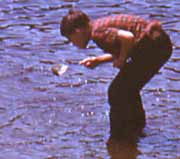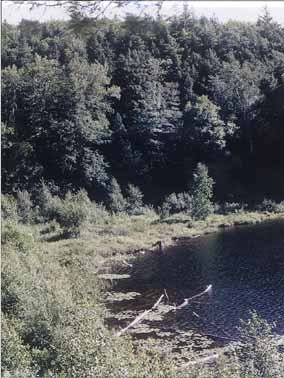

The Canadian Field-Naturalist
Like all Ottawa Field-Naturalists' Club (OFNC) members, the Macoun Field Club has a standing subscription to the Canadian Field Naturalist (CFN), as well as the more casual Trail & Landscape. We have seen, however, that only the keenest of our young people seem able to penetrate its professional aura. Judging by the individual article titles, it would appear to be a journal for specialists -- for botanists, ichthyologists, parasitologists, and wildlife managment officers. But in covering the widest possible range of natural history topics, the CFN offers its readers a window into these many specialized worlds that together make up modern natural history. This webpage is meant to encourage naturalists to read just enough to find the subjects of that are going to be of greatest personal interest to themselves.
Did you know that huge sharks (up to at least 20 feet long) can sometimes be found in the lower St. Lawrence River (Baie Comeau)? Or that there is no description in the scientific literature of them actively attacking living things? The general perception has been one of a sluggish, blind, olfactory scavenger of the Arctic deeps. A blind species? Not by heredity. Instead, infestation by an ocular parasite (a copepod) is almost universal in the species. Except, it now seems, in the Gulf of St. Lawrence.
An unusual inshore movement of capelin and seals in 2003 brought these sharks into the shallows where they could be observed by scuba divers. And the sharks observed back. The sharks, say the authors, "tracked divers with horizontal and vertical eye movements" through eyes that were clear (you can see that in the pictures). What is more, they reacted to the divers with tensed postures, rapid manoeuvers, and at least moderate swimming speed. Maybe they could catch something, after all.
 A more definitely viscious predatory fish is discussed in the very next article (pp. 359-366) -- Esox lucius, the Northern Pike, recently introduced to a little lake in Gatineau Park, across the river from Ottawa. Guess what happened.
A more definitely viscious predatory fish is discussed in the very next article (pp. 359-366) -- Esox lucius, the Northern Pike, recently introduced to a little lake in Gatineau Park, across the river from Ottawa. Guess what happened.
The same thing that happens if you put a baby pike into your tropical fish aquarium (as my cousins once did). One by one the other fish get eaten up. Ramsay Lake has (or had) the most diversified fish fauna of all Gatineau Park's small lakes (under 60 ha, or 150 acres). Within 12 years of the pike's appearance, 3 of the 17 species had already been extirpated. The young Macouner at right, photographed in Ramsay Lake in 1968, might have been finding Pearl Dace, Threespine or Fivespine Stickleback in his dipnet, but they are now gone. The authors of this paper (Josiane Vachon and her colleagues) predict which species will go next.
This kind of thing must have happened over and over again to little lakes all across North America. Is there a lake, a pond, a creek, or a river anywhere that someone hasn't tried to stock? People who like to catch fish like to let them go in new places, without the least interest in ecological consequences. Do you suppose anyone will own up to the deed?
 The story of ecological loss in another small lake in Gatineau Park (Black Lake) is highlighted by the CFN's cover picture. Most of this lake's shoreline is bedrock, but occupying the shallows in the coolest, shadiest corner is (or was) a tiny fen (a specialized kind of wetland). Joyce and Allan Reddoch, who took this photograph in 1971, visited the site over a period of decades to see the specialized community of plants living there. From time to time, they saw that by damming the lake's outflow, beavers were changing the lake level. The initial flooding in the late 1970s helped the fen by killing the encroaching trees that would have shaded it, but eventually, even higher water levels were drowning the fen, too. Only a few floating peat islets were perpetuating the fen community.
The story of ecological loss in another small lake in Gatineau Park (Black Lake) is highlighted by the CFN's cover picture. Most of this lake's shoreline is bedrock, but occupying the shallows in the coolest, shadiest corner is (or was) a tiny fen (a specialized kind of wetland). Joyce and Allan Reddoch, who took this photograph in 1971, visited the site over a period of decades to see the specialized community of plants living there. From time to time, they saw that by damming the lake's outflow, beavers were changing the lake level. The initial flooding in the late 1970s helped the fen by killing the encroaching trees that would have shaded it, but eventually, even higher water levels were drowning the fen, too. Only a few floating peat islets were perpetuating the fen community.
In 2003, the Reddochs found that the lake's beaver dam had washed out, dropping the water level 1 metre (40 inches). The formerly floating peat islets had become awkwardly stranded and were breaking up, with the unusual plants that had long lived there (including orchids) being replaced by common species.
Why should normal natural events -- the building and later collapse of a beaver dam -- have such a fatal effect on a fen that had persisted for a good many years? To understand this, the Reddochs reviewed their own notes going back 40 years for information about beavers and water levels at the lake, and examined aerial photographs from as early as 1925. Prior to that, they could find only the notes made by James Fletcher on July 8, 1878, and his subsequent articles on the flora of Ottawa, published in volumes 2 and 3 of the CFN.
Fletcher had, that summer day, collected the orchid Rose Pogonia from "a tiny bog at Black Lake". At 127 years, say the Reddochs, this is the longest-recorded orchid colony in the entire Ottawa region. And it is petering out.
Is this a completely natural event? Your answer to that question depends on how you think about the fur-trade's extirpation of the beaver, the logging industry's alteration of the surrounding forests, and the beaver's subsequent resurgence into places where it may not be able to maintain a stable population. With respect to the Black Lake fen, the answer may be that it survived several more minor, gradual adjustments to the water level, but that this one was, for the wetland, catastrophic.
 As I understand it from other sources, this strain of rabies used to be endemic in some restricted region of the eastern United States, but escaped its ecological constraints when raccoon hunters transported some animals northward. Subsequently, it spread more widely through the raccoon population and crossed the St. Lawrence River into Ontario just a few years ago. The Ontario MNR has reacted with determination to control its spread.
As I understand it from other sources, this strain of rabies used to be endemic in some restricted region of the eastern United States, but escaped its ecological constraints when raccoon hunters transported some animals northward. Subsequently, it spread more widely through the raccoon population and crossed the St. Lawrence River into Ontario just a few years ago. The Ontario MNR has reacted with determination to control its spread.
The worrisome thing about this variant of the disease is that raccoons infected with it don't give the classic behavioural warnings that would make one steer clear of a rabid animal. And raccoons are very often rather tame -- many people encourage them to come close by feeding them.
One of the methods the MNR uses is to catch, vaccinate, and release raccoons, and sometimes they subsequently find that the animal was already rabid. In this article, by Rick Rosatte and colleagues, one animal appeared normal except that it was making a high-pitched, whining sound. It was caught again the next day about a mile away, only now it was clearly sick: "very agitated, moving back and forth in the live-trap, turning upside down repeatedly, vocalizing with a high-pitched whine."
Another method for dealing with an instance of raccoon rabies is to remove all other raccoons, which may have been infected, from the surrounding area and euthanize them. Should the MNR have been doing this here? The authors point out that this would also remove all the vaccinated animals from the control zone, undoing much good work. And that in this instance and one other, through vaccination and release they were able to learn how far a rabid raccoon may travel. That information is both tremendously important, and enormously difficult to obtain.
All images donated by Macoun Club leaders, members, parents and friends. Created Dec. 11, 2006, and modified Jan. 23, 2007.